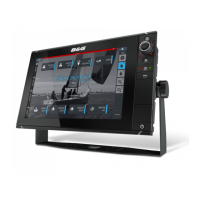18 |
Installation | Loop M User Manual
The bypass switch is optional and only necessary if you want to be able to bypass the relay/
software.
Device with bypass and external switch
3A
3G 3H
4D 4C 4B 4A
4E 4F 4G 4H
F
The example shows a load (bilge pump) connected between the DC negative bus and the
green connector pin 4D and 4C. Connector pin 4D is the output pin of relay R4 and can be
controlled from the Loop system. Connector pin 4C is the output pin of fuse F6 and can be
monitored (not controlled) from the Loop system.
A bypass switch is connected to the blue connector pin 3A. Connector pin 3A is the bypass
pin for relay R4. While the bypass switch is closed, the relay will be closed independent of the
status in the software. If the bypass switch is closed, it is not possible to turn the bilge pump
supply off from the software.
The bypass switch is optional and only necessary if you want to be able to bypass the relay.
The bilge pump in this example is equipped with a float switch and the bilge pump will be
running if the relay is closed or if the float switch is activated.
The Loop system will indicate when the bilge pump is running and if it is activated by the
loop system or by an external switch/bypass.
Device connected to a fuse output
4D 4C 4B 4A
4E 4F 4G 4H
The example shows a load (stereo amplifier) connected between the DC negative bus
and the green connector pin 4B. Connector pin 4B is the output pin of fuse F8 and can be
monitored (but not controlled) from the Loop system.

